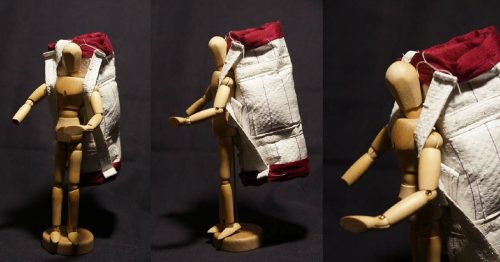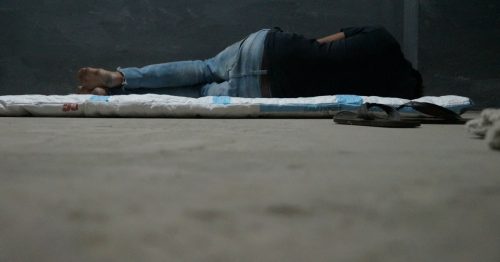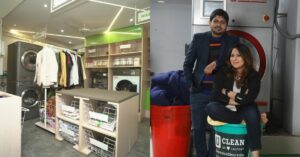Migrant Workers May Sleep Easy Thanks to this 22-Year-Old’s Innovation
Large quantities of badly treated waste coupled with poor housing options for migrant workers led Rhea Gupta to design an ergonomic product that tackles both these issues.

Google ‘industrial designer’ and the first hit says – Develops concepts and designs for manufactured products. Industrialist designers specialise in one product category, such as automobiles, furniture or housewares.
Typically, they work for large corporations. Today, however, I spoke to a student with such a qualification but different aspirations.
Meet Rhea Gupta, a 22-year-old graduate from the Srishti Institute of Art, Design and Technology in Bengaluru.

Rhea is qualified to model state of the art equipment for multinational corporations, except that’s not what she wants to do with her skill.
Behold the Upcycled Cement Holdall – an unusual pairing of words, which I will break down for you shortly. Before that, here’s how and why Rhea created this product.
During her course at Srishti, students were asked to work on an upcycling project, and for this, Rhea decided to conduct some of her primary research on construction sites.
Urban India has a booming construction economy, and of all the waste generated on these sites, what was most noticeable to Rhea were the plastic cement bags lying around.
India is the second largest producer of cement in the world. The many sacks of cement strewn around construction areas made her wonder what the impact the stray material has on the environment, especially since these bags are made of an exceptionally resilient kind of plastic – polypropylene.
While larger construction sites such as industries can afford to treat their waste in a more environmentally friendly approach, smaller housing sites usually are not able to.
Almost 90 percent of the people building these structures are migrants. They often reside near their workplaces in shabby makeshift houses. Hardly an uncommon sight to most of us.
Owners or contractors of such sites do not provide comfortable housing options, and because poor pay binds migrant labourers, they do not even have the choice of renting close by.
During a round of interviews she conducted in the city, Rhea tells me about an answer that stood out, “When I asked about their housing, one of them laughed and said, “If we’ve come from Bihar then our house would also be there, no?” This was when I realised that none of these workers have a place they can call home in the city. Moreover, for them to have a home in a new city is something they consider impossible.”
What was common to all these labourers was that they slept on site. Not on comfortable bedding, but on thin coir mats, laid out over uneven cement surfaces.
Talk Translates to Action: With a little help from a Freedom Fighter
After the interviews, Rhea realised that this assignment was about more than just a good grade. She tells me how it prompted a need for her to make a product that would improve the lives of a considerable portion of our population; in a way she knew best.
Putting two of the most significant challenges together – waste from cement bags, and deplorable living conditions of labourers, Rhea decided to create better bedding for workers on the move. But how was she going to design this in an economically viable fashion?
Her late Grandfather – a freedom fighter was the inspiration behind the idea. Mr Shivchand Ramsarup Gupta (1916-88) was active during the 1930s in the freedom struggle. Rhea tells me that his first encounter began when he wore the Gandhi topi to school, and was expelled for doing so!
“He then decided to get involved further into the freedom struggle. He was associated closely with activists like Moraji Desai, Jagjiwan Ram, Vasant Sathe, and many others,” says Rhea about a grandfather she never had the fortune of meeting.
How did someone she never met inspire her to come up with an ergonomic piece of furniture? “I have only seen remains of his things. His trunk, the first Indian flag made by hand. When I was talking to my father, he told to have a look at the mattress Dadaji used, and that’s when I saw his holdall, and the idea struck me!”
The Product: The Upcycled Cement Holdall


Upcycling, very plainly, is the practice to up the cycle of a product. It is the process of giving life to an object or material that appears exhausted and is ready to make its way to a landfill. When a product is upcycled, less waste is generated.
Traditionally, a holdall is a large rectangular bag with handles and a shoulder strap, used for carrying clothes and other personal belongings.
You may also like to read: Priorities for the Future: The Beauty of Indian Elections and What Must Change
Made out of four or more used cement bags, the upcycled cement holdall is stitched together with the thread that these bags are made of. Once stitched, it is used as a mattress, which can be rolled up after it’s used and carried around. It’s held together by straps that can be worn, resembling a backpack. It is six feet in length, and 3 feet in breadth.
“The Upcycled Hold-all is designed for that section of the economy that has unsanctioned or no homes at all. It is designed for those who work hard through long, unregulated working hours, and are not even promised a carefree, comfortable and restful sleep at night. It is designed for the migrant labour force of India,” says Rhea.
Distribution of the holdall
An innovative and socially conscious idea such as this must find it’s way to its intended beneficiaries, which is where Rhea has hit a roadblock. She tells me that she needs help to make this idea become a reality for the many migrant workers of our country.
Rhea is currently on the lookout for organisations she can partner with to make this happen.
What is clear from our conversation is Rhea wants to help the economically less fortunate. That is her calling as she says “I do not want to work with the big corporates. Designing their products is not what I want to do. I want to serve people in the villages, those who need it the most.“
If you can help Rhea give migrant labourers a more comfortable night’s sleep, then please contact her at [email protected]
Like this story? Or have something to share?
Write to us: [email protected]
Connect with us on Facebook and Twitter.
NEW: Click here to get positive news on WhatsApp!

Similar Story

Laundromats in India? Couple Built Rs 100 Crore Biz Washing Dirty Linen Across 100 Cities
Faridabad’s Arunabh Sinha and his wife Gunjan Taneja launched UClean in 2017 to set up an organised laundromat service in India. Currently, they are spread across 100+ cities and have 350+ outlets across the country.
Read more >
If you found our stories insightful, informative, or even just enjoyable, we invite you to consider making a voluntary payment to support the work we do at The Better India. Your contribution helps us continue producing quality content that educates, inspires, and drives positive change.
Choose one of the payment options below for your contribution-
By paying for the stories you value, you directly contribute to sustaining our efforts focused on making a difference in the world. Together, let's ensure that impactful stories continue to be told and shared, enriching lives and communities alike.
Thank you for your support. Here are some frequently asked questions you might find helpful to know why you are contributing?


This story made me
-
97
-
121
-
89
-
167












